Abstract
Volatile sulfur compounds (VSCs) are known to cause characteristic—and sometimes unpleasant—body odour. Human presence may influence the odour of indoor air; however, the contribution of skin-derived VSCs has not been thoroughly evaluated. This study aimed to elucidate the regional and whole-body dermal emission rates of VSCs—diallyl disulfide (DADS), allyl methyl sulfide (AMS), ethyl mercaptan (EMT), allyl mercaptan (AMT) and dimethyl trisulfide (DMTS)—by conducting simultaneous and multi-point measurements of dermal emissions from the human skin surface to assess their potential impact on indoor air quality. Dermal emission fluxes of VSCs were measured at 14 anatomical regions of 12 healthy young subjects using a passive flux sampler coupled with gas chromatography/mass spectrometry. These fluxes were converted to emission rates using regional body surface area, and the whole-body emission rates were subsequently used to estimate indoor air concentrations for comparison with the odour thresholds of each VSC. The results showed that although some regional differences in emission rates were observed among subjects, the large inter-individual variability ultimately led to no significant differences in whole-body emission rates of VSCs between males and females. Using the average whole-body emission rates across 12 subjects, the estimated indoor air concentrations of VSCs followed the descending order: EMT > AMT >> DMTS > AMS > DADS. The odour quotient was used to evaluate the impact of skin-derived VSCs on indoor air quality and indicated that EMT consistently contributes to indoor odour.
Keywords:
human skin gas; volatile sulfur compounds; emission; whole-body; indoor air; odour; human presence 1. Introduction
Volatile sulfur compounds (VSCs) are known to cause characteristic—and sometimes unpleasant—body odour [,]. Consumption of sulfur-rich foods (e.g., garlic, onions, cruciferous vegetables) is a typical source of volatile sulfur compounds (VSCs) generation in the human body. Garlic itself has an imperceptible smell; however, once chopped or crushed, alliin (S-allylcysteine sulfoxide), its natural constituent, is converted to allicin (diallyl thiosulfinate) through an enzyme-mediated process catalyzed by alliinase []. Allicin serves as a precursor to several VSCs, including diallyl disulfide (DADS) and allyl methyl sulfide (AMS), which are known to be responsible for the characteristic garlic odour that can persist for several hours to days [,,,]. DADS is produced from allicin and is subsequently metabolized into other compounds such as allyl mercaptan (AMT) and AMS. AMS is formed via rapid methylation of AMT [,]. Mercaptans have a malodorous smell, such as that of rotten cabbage []. Certain gut bacteria can metabolize sulfur-containing amino acids such as methionine and cysteine to produce ethyl mercaptan (EMT), which may contribute to human body odour [].
Recent studies have shown that the emission levels of VSCs from the human skin surface vary with physical, physiological, and psychological conditions. According to Katsuyama et al. [], AMT and dimethyl trisulfide (DMTS) were identified as sources of body odour in individuals experiencing tension. Similarly, Kyono et al. [] reported that the dermal emission rate of DADS tended to increase in subjects with poor sleep quality upon waking. Greater emissions of VSCs such as EMT, AMS, and methyl mercaptan have been observed in individuals who claim that their body odour or skin gases provoke allergy-like reactions in people nearby []. This phenomenon is referred to as “People Allergic to Me” (PATM), a medically unexplained condition. Accordingly, the dermal emission of VSCs is considered to play a role not only in sensory comfort or discomfort but also as a potential biological signal associated with human health.
Human skin gas, which contributes significantly to body odour, comprises a complex mixture of inorganic and organic volatile compounds. Although the complete profile of skin-emitted gases remains incompletely characterized, over 800 distinct compounds, including VSCs, have been identified to date [,]. These gases are released via three primary emission pathways: surface chemical reactions, sweat gland excretion, and transdermal diffusion from the bloodstream. Given the non-uniform distribution of blood vessels and sweat glands across different anatomical regions, the composition and quantity of skin gas emissions are presumed to vary spatially. Previous studies have quantified regional and whole-body dermal emission rates of compounds such as ammonia [] and acetic acid []; however, data regarding VSCs remain limited. Meanwhile, VSCs have attracted attention as indoor air pollutants [,,]. VSCs, though often present at trace levels in the low µg/m3 range, contribute significantly to odour nuisance and potential health risks in enclosed environments. Cooking activities and food waste have been suggested as sources of VSCs in indoor air []; however, the influence of human presence has not been reported. Body odour has been shown to exert a more pronounced influence on indoor air quality than oral malodour []. Therefore, the present study aims to elucidate the regional and whole-body dermal emission rates of five VSCs—including DADS, AMS, EMT, AMT, and DMTS—and to assess their potential impact on indoor air concentration and odour.
2. Methods
2.1. Subject Test
Multi-point measurement of skin-derived VSCs were carried out using a passive flux sampler (PFS, GL Sciences, MonoTrap® SG DCC18, GL Science, Tokyo, Japan) in conjunction with Gas Chromatography-Mass spectrometry (GC-MS) [,] by recruiting twelve healthy subjects (6 males and 6 females, age 21–23). The 14 PFSs were simultaneously deployed on the skin surface of 14 sampling sites of each subject for 1 h as shown in Figure 1. The sampling sites were decided by referring to the surface anatomical regions classified by Kurazumi et al. [], such as head, neck, chest, axilla, abdomen, back, lower back, upper arms, forearms, hands, buttocks, thighs, lower legs and feet.
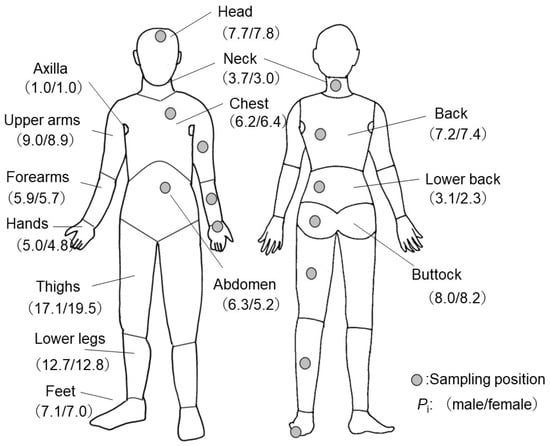
Figure 1.
Illustration of 14 body regions referred to the anatomical classification and sampling sites by the PFSs in this study. Values in parenthesis show the partial rates, Pi for male and female Japanese young adults cited and modified from [].
The PFS was simply composed of a polypropylene (PP) screw cap, a disk-type adsorbent as trapping media, and a PTFE O-ring and back-up plate as a stopper (Figure 2). The PFS was gently affixed by a piece of medical tap to the skin surface to create a headspace. The skin-derived VSCs diffuses in the headspace by molecular diffusion and were subsequently collected by the trapping medium composed of monolithic silica embedded with activated carbon particles. The diffusion length, which is the distance between the skin surface and the trapping medium in the PFS, was set to 0.80 cm. The subject test was conducted during the daytime in a laboratory at Tokai University, Japan. The room temperature was approx. 293 K and relative humidity was approx. 53%. All subjects took off their shoes and kept relaxed and quiet during the sampling to prevent excess sweating. The skin surface was not specially treated prior to sampling.
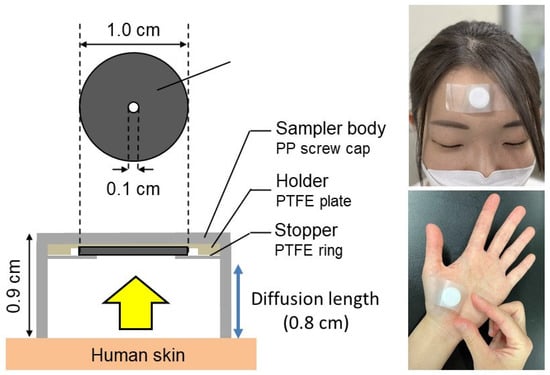
Figure 2.
Schematic view of the PFS for the non-invasive collection of VSCs emanating from human skin surface. The PFSs were fixed by a piece of surgical tape for 1 h.
After sampling, trapped VSCs were eluted into 0.50 mL carbon disulfide (FUJIFILM Wako Pure Chemical Pure Chemical Corporation, Osaka, Japan) with 30 min of ultrasonic extraction. The chromatographic analysis was performed for the extracts using a gas chromatograph model 7890B (Agilent Technologies, Santa Clara, CA, USA) and a mass selective detector, JMS-Q1050GC MkII (JEOL, Tokyo, Japan). One microlitre of sample extracts, blank extracts, and quantitation standards were injected with a split ratio of 35:1 into a DB-IMS capillary column (30 m × 0.25 mm I.D. × 0.25 µm film thickness, Agilent Technologies, Santa Clara, CA, USA) and a DB-35MS capillary column (30 m × 0.25 mm I.D. × 0.25 µm film thickness, Agilent Technologies, Santa Clara, CA, USA). The carrier gas was G1 grade helium (Taiyo Nippon Sanso, Tokyo, Japan) at a flow rate of 1.0 mL min−1. The injector port was maintained at 280 °C. The oven temperature was programmed as follows: held at 50 °C for 8 min, ramped at 6 °C·min−1 to 120 °C, and ramped at 20 °C·min−1 to 300 °C and held for 2 min. Signals for sample extracts were acquired using a real-time Selected Ion Monitoring mode.
The dermal emission flux of the target VSCs at a sampling site, Ei (ng cm−2 h−1) was obtained by
where Wi is a collection amount of each VSC (ng) at a sampling site, i, S’ is an effective cross-section of the trapping media (0.594 cm2) and t is a sampling duration (1.0 h).
2.2. Regional and Whole-Body Dermal Emission Rate of VSCs
The whole-body surface areas, S (cm2) of twelve subjects were calculated using their weights, W (kg) and heights, H (cm) by Equation (2), which is the formula developed for Japanese young adults [].
The whole-body surface area of a subject was then distributed among 14 regions using the partial rates Pi, as shown in Figure 1. Assuming the emission flux at the sampling site represents that of the anatomical region, dermal emission rate of each VSC at a certain body region, Mi (μg h−1) was obtained from Ei and partial body surface Si (cm2).
Thus, the whole-body emission rate M (µg h−1) of each VSC was estimated by summation of Ei for each subject.
2.3. Impact of Skin-Derived VSCs on Indoor Air Quality
To assess the potential exposure to VSCs released from an emitting individual in a room, a two-component box model—comprising near-field and far-field zones [,]—was used to estimate the diffusion concentrations of key VSCs. The region surrounding the emitter was modelled as a well-mixed box (near field), while the remainder of the room was treated as another well-mixed box (far field). A defined volume of air was exchanged between the two zones. Assuming steady-state conditions, the indoor air concentration of VSCs transferred from the emitter to the near field, denoted as (g·m−3), was calculated using Equation (5).
CNF = M/Q + M/β
M represents the whole-body emission rate of skin gas from an emitting individual, as determined by Equation (4). The air change rate, Q, was set at 16 m3·h−1, based on the assumption of a typical Japanese residential room with an internal volume of 32 m3 and an air exchange rate of 0.5 h−1. The term β denotes the exchange rate between the two boxes and is defined as a function of the distance between the emitter and a neighbouring individual—specifically, the radius, r (m) of the hemisphere representing the near-field box—as shown in Equation (6):
where v is an air flow (m h−1) in a room. The diffusion concentrations at a distance of 0.3 m apart from an emitting individual were calculated using the average dermal emission fluxes of VSCs measured from twelve subjects. The airflow was set at 0.060 m s−1 (=216 m h−1). Since the β increases with longer r and M/β is asymptotic to zero, indoor air concentration of VSCs in far-field CFF can simply be obtained by Equation (7).
β = πr2v
CFF = M/Q
To assess the relative odour strength of skin-derived VSCs, the odour quotient (OQ) [] was obtained by comparing CNF and CFF to the odour threshold value, OT (g m−3) of each VSC [], converted from the reported values (ppb) at 298 K.
OQ = CNF or CFF/OT
2.4. Quality Assurance and Quality Control
Calibration was constructed using a mixed dilution series of analytes at concentrations of 0, 0.50, 1.0 and 2.5 µg mL–1. All reagents were purchased from FUJIFILM Wako Pure Chemical Corporation, except DMTS, which was obtained from Tokyo Kasei (Tokyo, Japan), and diluted with carbon disulfide. An excellent linear correlation was observed between the GC-MS signal response and the analyte concentrations across this range, with coefficients of determination (R2) exceeding 0.99, demonstrating the high reliability and robustness of the analytical method. The recovery rates of the trapped VSCs were investigated by administering known amounts of each VSC to the trapping medium, resulting in recoveries greater than 95% for all VSCs. Based on these excellent recovery rates, the limits of detection (LODs) for each VSC were determined using a signal-to-noise ratio (S/N) of 3, calculated from the areas obtained from the mixed standard solutions and Equation (1). The LODs resulted in 0.049 ng cm−2 h−1 for DADS, 0.005 ng cm−2 h−1 for AMS, 0.014 ng cm−2 h−1 for AMT, 0.080 ng cm−2 h−1 for DMT, and 0.068 ng cm−2 h−1 for EMT. Since the dermal emission fluxes of these VSCs are very low, values above the LODs were adopted, while those below the LODs were treated as zero in this study.
2.5. Statistical Analysis
IBM SPSS statistics 25 was used to perform the statistical analyses. Differences in the dermal emission flux and emission rate among sampling regions were analysed using ANOVA, and those between males and females were analysed using Wilcoxon rank sum test. The cluster analysis was conducted on the average of dermal emission fluxes of each VSC at 14 sampling sites. Unless indicated otherwise, statistical significance was set at p < 0.05.
3. Results and Discussion
3.1. Dermal Emission Fluxes of VSCs at 14 Sampling Sites
The VSCs measured in this study are considered to be endogenous chemicals derived from bloodstream and are thought to be released from various regions of the body []. However, information on differences among body regions was limited. The emission flux of skin gases represents the amount emitted per unit area and per unit time, and it is possible to compare which parts are likely to be emitted per area. Therefore, effect of sampling site on the dermal emission fluxes of DADS, AMS, AMT, DMT and EMT was investigated by deploying the PFSs on 14 sampling sites of twelve subjects simultaneously. As the objective of this study was to elucidate the real-life skin emission of VSCs, the skin surface of participants was not specially treated prior to sampling.
Figure 3 shows comparison of emission fluxes in a box plot. The “x” denotes arithmetic mean calculated for all subjects (n = 12). Each VSC was detectable in most cases, and the mean emission flux with standard deviation resulted in 0.076 ± 0.12 ng cm−2 h−1 for DADS, 0.26 ± 0.29 ng cm−2 h−1 for AMS, 4.6 ± 5.2 ng cm−2 h−1 for EMT, 4.3 ± 4.3 ng cm−2 h−1 for AMT, and 0.43 ± 0.71 ng cm−2 h−1 for DMTS, in total 168 samples. Comparing the levels of cutaneous emission flux between VSCs, EMT was the highest, followed by AMT, AMS and DMTS were at the same level, and DADS was the lowest.
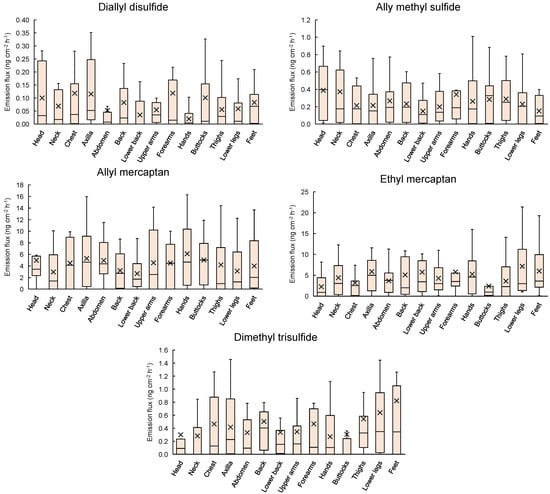
Figure 3.
Comparison of emission flux of VSCs emanating from 14 sampling sites of twelve young healthy subjects.
Since there were substantial variations in the measured data among subjects, differences between males and females across sampling sites were not remarkably found for each VSC. Although no significant differences were found among sampling sites for each VSC (ANOVA, p > 0.005), the emission flux tended to vary depending on the sampling site. For example, DADS tended to show higher levels at the head, axilla, forearms, and buttocks, whereas lower levels were observed in the abdomen and hands. In contrast, EMT exhibited higher levels in the legs and feet, and lower levels in the chest and buttocks.
To examine the similarity in distribution patterns across body regions, cluster analysis was conducted using the mean values of each compound at each site. Euclidean distance [] was employed to evaluate inter-compound similarity, resulting in the dendrogram shown in Figure 4. Notably, similar results were obtained when using median values. Interestingly, compounds with sulfide (-S-) structures—DADS, AMS, and DMTS—showed shorter Euclidean distances among themselves and formed a distinct cluster from EMT and AMT, which possess thiol (-SH) groups. Physical conditions such as local blood perfusion [] and skin thickness [] are considered to influence the differences in site-specific emission of blood-route derived VSCs. In addition, these findings suggest that the chemical structure of sulfur atoms may also be associated with the site-specific emission behaviour of VSCs, even though the formation mechanisms are different; DADA, AMS and AMT are allicin-origin compounds [,,,], and EMT and DMTS may have other origins.
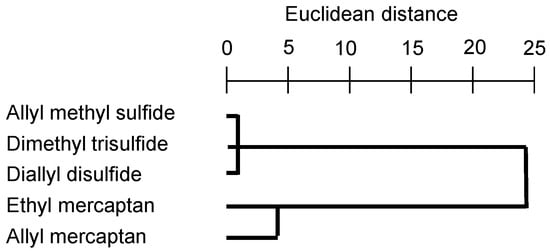
Figure 4.
Similarity in inter-regional differences in VSC emission fluxes (shorter distances correspond to greater similarity).
3.2. Regional and Whole-Body Dermal Emission Rate of VSCs
To compare the emission amounts of volatile sulfur compounds (VSCs) per unit time from each body region, the emission rate Mi for each site was calculated. The total body surface area S (cm2) was estimated from each subject’s body weight B (kg) and height H (cm), and the surface area Si (cm2) of each region was derived using the regional surface area ratio Pi shown in Figure 1. Table 1 presents the estimated total surface area S and regional surface areas Si for the 12 subjects. The average total body surface area was 1.6 m2 overall, with 1.7 m2 for males and 1.5 m2 for females. As predicted, the average surface area of male subjects was greater than that of female participants. Using the partial surface areas and emission fluxes measured at 14 sampling sites per subject, the VSC emission rates for each of the 14 body regions were calculated separately for male and female participants.

Table 1.
Calculated whole and partial body surface areas of twelve Japanese young subjects using the formulas developed by Kurazumi et al. [].
Figure 5 shows a comparison of the emission rates of VSCs across 14 body regions in female and male participants. For DADS, although some male subjects exhibited relatively higher emission rates at the buttocks and thighs, no significant differences were observed among sampling sites or between sexes. Regarding AMS, significant differences in emission rates across body regions were found in female participants (ANOVA, p < 0.001), with relatively higher levels detected at the thighs, lower legs, head, and chest, and lower levels at the axilla. Additionally, emission rates at the lower legs and chest were significantly higher in females than in males (Wilcoxon rank sum test, p < 0.05). For EMT, significant regional differences were observed in females (p = 0.037), with higher levels at the thighs and lower legs and lower levels at the axilla. Significant differences were also found in males (p = 0.035), with relatively higher levels at the lower legs, feet, and back, and lower levels at the axilla. However, no significant sex differences were observed at any individual site. In the case of AMT, no significant regional differences were found in either sex. Nevertheless, higher emission rates tended to be observed at muscle-rich regions such as the upper arms, thighs, and lower legs. Moreover, male participants showed significantly higher emission rates at the abdomen and back. For DMTS, significant regional differences in emission rates were observed in female participants (ANOVA, p = 0.006), with higher levels at the thighs, lower legs, and feet, and lower levels at the axilla, neck, and buttocks. Again, no significant sex differences were found at any site.
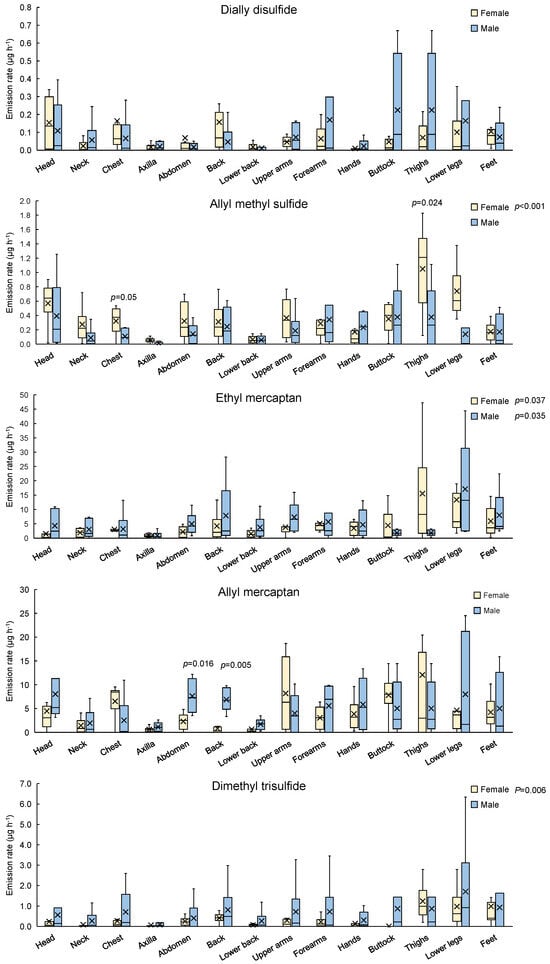
Figure 5.
Comparison of dermal emission rates of VSCs among 14 body regions (ANOVA) and those between males and females (Wilcoxon rank sum test).
Taken together, these results indicate that female participants tended to exhibit more pronounced regional variation in emission rates—particularly for AMS, EMT, and DMTS—with higher levels observed in the lower body regions such as the thighs and lower legs, which are typically more muscular. Although the axilla is known to emit strong odours such as those associated with axillary osmidrosis, which is a medical condition characterized by offensive body odour originating from apocrine gland secretion at armpits [,], the VSCs examined in this study showed the lowest emission rates at this site, suggesting a minimal contribution to whole-body VSC emission. Furthermore, aside from certain regions for AMS and AMT, no significant sex differences were observed in emission rates. This indicates that whole-body emission rates of VSCs did not differ between males and females. Therefore, whole-body emission rates yielded average values ± standard deviation across all subjects of 1.1 ± 0.80 µg h−1 person−1 for DADS, 4.1 ± 2.3 µg h−1 person−1 for AMS, 74 ± 52 µg h−1 person−1 for EMT, 70 ± 33 µg h−1 person−1 for AMT, and 7.8 ± 11 µg h−1 person−1 for DMTS. Comparing with previous studies for other skin gases [,], these values are considerably lower than those of ammonia (5.9 ± 3.2 mg h−1 person−1) and acetic acid (5.6 ± 2.2 mg h−1 person−1). Ammonia, a metabolite of proteins and amino acids, is emitted via the blood route and perspiration. Meanwhile, acetic acid is mainly generated by intestinal bacteria from dietary fibre and related substrates, enters the bloodstream, and is subsequently secreted through the eccrine sweat glands. Accordingly, these differences are likely due to the variation in dietary precursor availability and differences in emission pathways.
3.3. Impact of Skin-Derived VSCs on Indoor Air Quality
Using whole-body emission rates, indoor air concentrations of skin-derived VSCs were estimated based on the near-field and far-field model. Figure 6 presents the estimated concentrations of VSCs in a room, showing the following descending order: EMT > AMT >> DMTS > AMS > DADS. To assess the relative odour strength of skin-derived VSCs, the odour quotient (OQ)—defined as the ratio of indoor air concentration to the odour threshold value—was calculated. An OQ greater than unity indicates that the compound may contribute to an indoor odour detectable by humans []. Since reliable odour threshold values have not been reported for AMT and DMTS, the OQ was calculated only for the other VSCs using the threshold values of 1.3 µg m−3 for DADS, 0.50 µg m−3 for AMS, and 0.022 µg m−3 for EMT []. As a result, EMT showed an OQ of 210 in the far-field (OQFF) and 265 in the near-field (OQNF), indicating that it consistently contributes to indoor odour and can be considered a skin gas component that signals human presence in indoor environments. In contrast, DADS had an OQFF of 0.06 and OQNF of 0.072, while AMS had an OQFF of 0.51 and OQNF of 0.65, suggesting that these compounds generally have minimal impact on indoor odour under normal conditions. However, DADS and AMS are known as major components of garlic odour [,,,], and their influence may become pronounced following garlic ingestion. Additionally, DADS emission flux tends to increase upon waking, particularly when sleep quality is poor [], implying that the presence of these odours in indoor air may reflect human activities and physiological states.
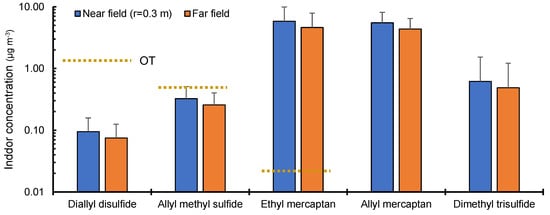
Figure 6.
Estimated indoor air concentrations of VSCs in near-field (r = 0.3 m) and far-field zones. Error bars show standard deviations of estimated values for tested subjects (n = 12). Dashed lines show the odour threshold (OT) values of DADS, AMS and EMT converted at 298 K.
A limitation of this study is that the participants were restricted to young, healthy individuals aged 21 to 23. It is known that certain components of skin gas emission flux are age-dependent, although it remains unclear whether the five VSCs examined in this study exhibit such age dependency. Moreover, other VSCs—such as methyl mercaptan—may also significantly influence body odour. Further investigation of these compounds will require improvements to the analytical methodology to enhance sensitivity.
4. Conclusions
To assess the potential impact of skin-derived VSCs on indoor air quality, this study aimed to elucidate the regional and whole-body dermal emission rates of five VSCs, DADS, AMS, AMT, DMTS, and EMT, by conducting simultaneous, multi-point measurements of their dermal emission from the human skin surface in twelve healthy young volunteers using the PFS-GC/MS methodology. As a result, no significant difference was found in the whole-body emission rates of VSCs between males and females, with average values ± standard deviation across all subjects as follows: 1.1 ± 0.80 µg·h−1 for DADS, 4.1 ± 2.3 µg·h−1 for AMS, 74 ± 52 µg·h−1 for EMT, 70 ± 33 µg·h−1 for AMT, and 7.8 ± 11 µg·h−1 for DMTS. The estimated indoor air concentrations of VSCs followed the descending order: EMT > AMT >> DMTS > AMS > DADS. The odour quotient (OQ) was used to evaluate the impact of skin-derived VSCs on indoor air quality and indicated that EMT consistently contributes to indoor odour. EMT can thus be considered a skin gas component that signals human presence in indoor environments. Such fundamental studies are valuable for understanding the mechanisms of body odour and for evaluating the potential effects of skin-emitted gases on indoor environmental quality.
Author Contributions
Conceptualization, Y.S.; methodology, Y.S. and T.O.; validation, Y.S., T.O., D.S. and A.H.; formal analysis, T.O. and M.F.; investigation, T.O., D.S., A.H. and M.F.; resources, Y.S.; data curation, T.O.; writing—original draft preparation, Y.S. and T.O.; writing—review and editing, D.S., A.H. and M.F.; project administration, Y.S. All authors have read and agreed to the published version of the manuscript.
Funding
This research received no external funding.
Institutional Review Board Statement
The study was conducted in accordance with the Declaration of Helsinki and approved by the Institutional Review Board of Shonan Campus, Tokai University, Japan (No. 23048, 24012).
Informed Consent Statement
Written informed consent has been obtained from the patient(s) to publish this paper.
Data Availability Statement
All data are included in this published article.
Acknowledgments
Authors thank Kotomi Nagano, Tokai University; Joe Kochi, Tokai University; and Michihito Todaka, AIREX Inc. for their kind support in this study.
Conflicts of Interest
The authors declare no conflicts of interest.
References
- Vitko, T.G.; Cowden, S.; Suffet, I.H.M. Evaluation of bioscrubber and biofilter technologies treating wastewater foul air by a new approach of using odor character, odor intensity, and chemical analyses. Water Res. 2022, 15, 118691. [Google Scholar] [CrossRef]
- Mirondo, R.; Barringer, S. Deodorization of garlic breath by foods, and the role of polyphenol oxidase and phenolic compounds. J. Food Sci. 2016, 81, C2425–C2430. [Google Scholar] [CrossRef] [PubMed]
- Nadeem, M.S.; Kazmi, I.; Ullah, I.; Muhammad, K.; Anwar, F. Allicin, an Antioxidant and Neuroprotective Agent, Ameliorates Cognitive Impairment. Antioxidants 2021, 11, 87. [Google Scholar] [CrossRef] [PubMed]
- Sato, S.; Sekine, Y.; Kakumu, Y.; Hiramoto, T. Measurement of diallyl disulfide and allyl methyl sulfide emanating from human skin surface and influence of ingestion of grilled garlic. Sci. Rep. 2020, 10, 465. [Google Scholar] [CrossRef] [PubMed]
- Haggard, H.W.; Greenberg, L.A. Breath odors from alliaceous substance: Cause and remedy. J. Am. Med. Assoc. 1935, 104, 2160–2163. [Google Scholar] [CrossRef]
- Minami, T.; Boku, T.; Inada, K.; Morita, M.; Okazaki, Y. Odor components of human breath after the ingestion of grated raw garlic. J. Food Sci. 1989, 54, 763–765. [Google Scholar] [CrossRef]
- Taucher, J.; Hansel, A.; Jordan, A.; Lindinger, W. Analysis of compounds in human breath after ingestion of garlic using proton-transfer-reaction mass spectrometry. J. Agric. Food Chem. 1996, 44, 3778–3782. [Google Scholar] [CrossRef]
- Hosomi, K.; Kunisawa, J. Intestinal metabolic environment created with diets and gut microbiota and its impact on our health. J. Jpn. Biochem. Soc. 2023, 95, 450–456. [Google Scholar] [CrossRef]
- Katsuyama, M.; Narita, T.; Nakashima, M.; Kusaba, K.; Ochiai, M.; Kunizawa, N.; Kawaraya, A.; Kuwahara, Y.; Horiuchi, M.; Nakamoto, K. How emotional changes affect skin odor and its impact on others. PLoS ONE 2022, 17, e0270457. [Google Scholar] [CrossRef]
- Kyono, A.; Takei, R.; Murase, M.; Fujioka, Y.; Sekine, Y. Human skin gas components which affect the quality of sleep. In Proceedings of the 37th Annual Conference of the Society for Odor and Flavor Environmental Science, Tokyo, Japan, 29–30 August 2024; p. 4. (In Japanese). [Google Scholar]
- Sekine, Y.; Oikawa, D.; Todaka, M. Human skin gas profile of individuals with the people allergic to me phenomenon. Sci. Rep. 2023, 13, 9471. [Google Scholar] [CrossRef]
- Mitra, A.; Choi, S.; Boshier, P.R.; Razumovskaya-Hough, A.; Belluomo, I.; Spanel, P.; Hanna, G.B. The Human Skin Volatolome: A Systematic Review of Untargeted Mass Spectrometry Analysis. Metabolites 2022, 12, 824. [Google Scholar] [CrossRef]
- Furukawa, S.; Sekine, Y.; Kimura, K.; Umezawa, K.; Asai, S.; Miyachi, H. Simultaneous and multi-point measurement of ammonia emanating from human skin surface for the estimation of whole body dermal emission rate. J. Chromatogr. B Analyt. Technol. Biomed. Life Sci. 2017, 1053, 60–64. [Google Scholar] [CrossRef] [PubMed]
- Sekine, Y.; Nikaido, N.; Sato, S.; Todaka, M. Trace biogases emanating from human skin surface—Acetic acid as a possible biomarker for sweating. Frag. J. 2018, 2018, 19–25. (In Japanese) [Google Scholar]
- Wei, Y.; Wang, X.; Ji, M.; Deng, S.; Zhou, M.; Huang, L. Volatile organic compounds in residential indoor environments in winter: A field investigation in Beijing. Air Qual. Atmos. Health 2025, 18, 1115–1126. [Google Scholar] [CrossRef]
- Kim, K.Y.; Kim, J.K. Indoor concentration distributions of ammonia and sulfur-based odorous substances according to types of laying hen houses in South Korea. Atmosphere 2024, 15, 980. [Google Scholar] [CrossRef]
- You, B.; Zhou, W.; Li, J.; Li, Z.; Sun, Y. A review of indoor Gaseous organic compounds and human chemical Exposure: Insights from Real-time measurements. Environ. Int. 2022, 170, 107611. [Google Scholar] [CrossRef]
- Tsushima, S.; Wargocki, P.; Tanabe, S. Sensory evaluation and chemical analysis of exhaled and dermally emitted bioeffluents. Indoor Air 2018, 28, 146–163. [Google Scholar] [CrossRef]
- Kurazumi, Y.; Horikoshi, T.; Tsuchikawa, T.; Matsubara, N. The body surface area of Japanese. Jpn. J. Biometeorol. 1994, 31, 5–29. (In Japanese) [Google Scholar]
- Ramachandran, G. Occupational Exposure Assessment for Air Contaminants. In Exposure Modelling; CRC Press: Boca Raton, FL, USA, 2005; Chapter 17; pp. 286–289. [Google Scholar] [CrossRef]
- Kim, K.H.; Park, S.Y. A comparative analysis of malodor samples between direct (olfactometry) and indirect (instrumental) methods. Atmos. Environ. 2008, 42, 5061–5070. [Google Scholar] [CrossRef]
- Japan Association on Odor Environment, Odor Threshold Values of Odorous Chemicals. Available online: https://orea.or.jp/gijutsu/kyuukakusokuteihou/odor-threshold-values/ (accessed on 19 February 2023).
- Ultsch, A.; Lötsch, J. Euclidean distance-optimized data transformation for cluster analysis in biomedical data (EDOtrans). BMC Bioinform. 2022, 23, 233. [Google Scholar] [CrossRef]
- Jia, S.; Wang, Q.; Li, H.; Song, X.; Wang, S.; Zhang, W.; Wang, G. The relationship between blood perfusion in the lower extremities and heart rate variability at different positions. Front. Physiol. 2021, 12, 656527. [Google Scholar] [CrossRef]
- Lintzeri, D.A.; Karimian, N.; Blume-Peytavi, U.; Kottner, J. Epidermal thickness in healthy humans: A systematic review and meta-analysis. J. Eur. Acad. Dermatol. Venereol. 2022, 36, 1191–1200. [Google Scholar] [CrossRef]
- Morioka, D.; Nomura, M.; Lan, L.; Tanaka, R.; Kadomatsu, K. Axillary Osmidrosis: Past, Present, and Future. Ann. Plast. Surg. 2020, 84, 722–728. [Google Scholar] [CrossRef]
- Baumann, T.; Bergmann, S.; Schmidt-Rose, T.; Max, H.; Martin, A.; Enthaler, B.; Terstegen, L.; Schweiger, D.; Kalbacher, H.; Wenck, H.; et al. Glutathione-conjugated sulfanylalkanols are substrates for ABCC11 and γ-glutamyl transferase 1: A potential new pathway for the formation of odorant precursors in the apocrine sweat gland. Exp. Dermatol. 2014, 23, 247–252. [Google Scholar] [CrossRef]
Disclaimer/Publisher’s Note: The statements, opinions and data contained in all publications are solely those of the individual author(s) and contributor(s) and not of MDPI and/or the editor(s). MDPI and/or the editor(s) disclaim responsibility for any injury to people or property resulting from any ideas, methods, instructions or products referred to in the content. |
© 2025 by the authors. Licensee MDPI, Basel, Switzerland. This article is an open access article distributed under the terms and conditions of the Creative Commons Attribution (CC BY) license (https://creativecommons.org/licenses/by/4.0/).